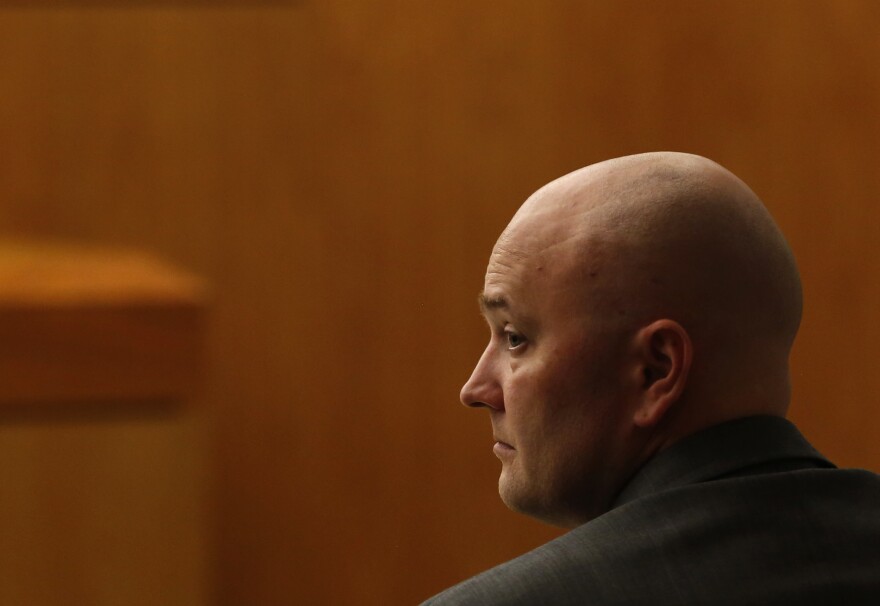The trial of former Balch Springs police officer Roy Oliver continues this week in Dallas.
He’s facing murder charges for shooting into a car full of teenagers leaving a party in April 2017 and killing 15-year-old Jordan Edwards. It’s one of several controversial police shootings of black men, teenagers and boys that have grabbed national headlines.
But it’s rare that a case like this makes it to court.
“By my count, only 93 officers across the country have been charged with murder or manslaughter as the resulting from an on-duty shooting,” said Phil Stinson, a criminologist at Bowling Green State University in Ohio who used to be a police officer.
“Just 93 over about 14 years,” he said.
Stinson studies what happens when police commit crimes. He says when an officer shoots and kills someone without legal justification, it’s illegal.
Nationwide, police shoot and kill between 900 and 1,000 people each year in the line of duty, although exact data is hard to come by. There is no federal database for police shootings.
Many of those shootings are determined to be justified and therefore legal, but even many controversial cases don’t make it to court. That includes officers who killed Michael Brown in Ferguson, Missouri; Tamir Rice in Cleveland; and Alton Sterling in Baton Rouge.
Of those 93 officers who have been charged over the last 14 years with illegally shooting and killing someone in the line of duty, only 32 have been convicted of a crime: 16 by guilty plea, 16 by jury trial, according to Stinson. Forty-one had the charges dropped, or their cases ended in a mistrial or acquittal; 20 cases are pending.
Even in cases where the prosecutors seem to have overwhelming evidence, Stinson says prosecutors face a number of legal, social and institutional challenges to securing a conviction. For one, the laws governing whether an officer is allowed to use lethal force are pretty broad.
“The standard that the United States Supreme Court has laid down is that an officer [is] justified in using deadly force if that officer has a reasonable apprehension of an imminent threat of serious bodily injury or deadly force [is] being used against the officer or someone else,” Stinson explained.
"Often, prosecutors are hesitant to even bring charges."
Basically, if officers fear for their lives or the lives of others, they’re allowed to shoot and kill a suspect. It’s a standard that tilts in favor of officers, according to Brian Owsley, a law school professor at the University of North Texas at Dallas. He says there’s reason for that.
“Let’s be clear: Law enforcement officers, police officers have a very difficult job,” Owsley said. “And they’re called upon to make decisions in split seconds.”
That means prosecutors have to convince juries that the officer acted intentionally or negligently to kill someone — and that it wasn’t reasonable to think the officer was in fear for his or her life.
“Often, prosecutors are hesitant to even bring charges,” Owsley said.
Prosecutors work hand in glove with local police departments, which Owlsey says can act as an institutional deterrent to bringing charges against one of those departments’ officers.
Pamela Metzger from the Deason Criminal Justice Reform Center at the Southern Methodist University law school says it’s simply human.
“Prosecutors build up long-term, meaningful relationships with their investigators, with police officers,” Metzger said. “So, it’s very difficult from a cognitive perspective to think, ‘These guys we’ve been working with all these years, they’re killers.’ No one wants to believe that.”
And even when they do bring charges, convincing a jury or a judge that the officer broke the law when they killed a person is tough. That’s partly because most people, especially wealthier and white people, tend to give the police the benefit of the doubt, Metzger says.
“We start with a general presumption of good faith,” she said. “Now, that’s not the way [all] communities feel, but as a society that’s our cultural narrative.”
Metzger says we really don’t know what happens when juries deliberate, but these are hard cases to consider — and a guilty verdict in Texas and most of the country requires a unanimous decision. And many jurors seem loathe to second-guess an officer’s heat-of-the-moment judgment call.
"We start with a general presumption of good faith."
“We only give jurors two choices: Guilty or not guilty. We don’t give them, ‘We wish you’d done a better job.’ We don’t give them, ‘You need to be retrained.’ We don’t give them, ‘You’re guilty, but it’s not the same as a hitman style murder.’ Those are not on the menu. You get one choice: Guilty or not guilty.”
After he shot Edwards, Oliver wrote in his report that he fired into the car because it was advancing toward him and he feared for his life. Body and dash cam video showed the car moving away from him and Oliver’s partner testified that he did not fear for his own life.
Dallas County District Attorney Faith Johnson has video evidence and police testimony on her side, but Metzger says it’s far from a sure thing it’ll be enough to convict Roy Oliver.





